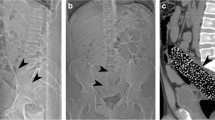Abstract
Smuggling of contraband in the pelvic body cavities is a continuing problem at prisons and border crossings. The body cavity screening system is a specialized magnetic resonance imaging (MRI) system for revealing weapons and other materials carried in the vaginal and rectal body cavities. A prototype system has been tested, demonstrating high detection probability for a wide range of contraband materials. A new chair-configuration MRI system has been designed for rapid imaging and ease of use in a corrections environment. This work was supported by the U.S. National Institute of Justice.
Similar content being viewed by others
References
Stark D., Bradley W.: Magnetic Resonance Imaging. St. Louis: Mosby 1999.
Semelka R., Ascher S., Reinhold C.: MRI of the Abdomen and Pelvis. New York: Wiley 1997.
Haase A., Frahm J.G., Matthai D., Hanicke W., Merboldt K.D.: J. Magn. Reson.67, 258–266 (1986)
Kramer D.M., Guzman R.J., Carlson J.W., Crooks L.E., Kaufman L.: Radiology173, 541–544 (1989)
Author information
Authors and Affiliations
Rights and permissions
About this article
Cite this article
Newman, D.E., Barrall, G.A. Detection of contraband in pelvic body cavities. Appl. Magn. Reson. 25, 577–584 (2004). https://doi.org/10.1007/BF03166549
Received:
Revised:
Issue Date:
DOI: https://doi.org/10.1007/BF03166549




